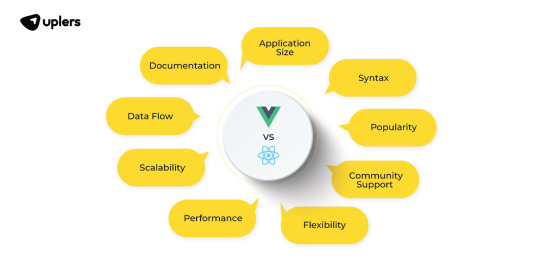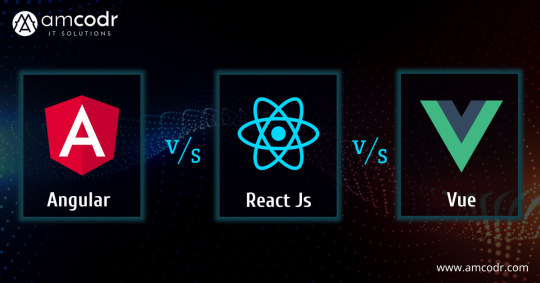#react vs vue
Explore tagged Tumblr posts
Text
Vue vs. React: Which is the Better Front-end JS Framework

In the ever-evolving world of web development, choosing the right front-end JavaScript framework is crucial for building efficient, scalable, and maintainable web applications.
Two of the most popular options that have dominated the landscape are react vs vue In this blog post, we will dive into the key differences between Vue vs React, discuss their pros and cons, and help you make an informed decision about which one suits your project's needs.
What is React?
React, developed and maintained by Facebook, is an open-source JavaScript library designed for building user interfaces. It was released in 2013 and has since gained immense popularity in the web development community. React follows a component-based architecture, allowing developers to create reusable UI components that can be composed to build complex user interfaces.
What is Vue?
Vue.js, often referred to as Vue, is another open-source JavaScript framework for building user interfaces. Created by Evan You in 2014, Vue has steadily grown in popularity due to its simplicity and flexibility. Vue is often praised for its ease of use and gentle learning curve, making it an attractive option for both beginners and experienced developers.
Differences between Vue and React
Here, we have explained vuejs vs react, read out the difference between vue and react-

1. Learning Curve
One of the most significant differences between Vue and React is the learning curve. React has a steeper learning curve, especially for beginners, due to its use of JSX (JavaScript XML) and a more complex setup. In contrast, Vue provides a more intuitive and gradual learning experience, making it easier for newcomers to get started.
2. Ecosystem
React boasts a robust ecosystem with a vast number of third-party libraries and tools. This rich ecosystem can be both a blessing and a curse, as it offers a wide range of choices but may also lead to decision paralysis. Vue, on the other hand, provides a more opinionated ecosystem, which can simplify the development process by offering guidance on best practices and tooling.
3. Integration
React is often preferred for projects that require a high level of integration with other technologies, such as server-side rendering (SSR) and native mobile app development. React Native, a framework for building mobile apps, allows developers to leverage their React skills to create mobile applications. Vue, while still capable of SSR and mobile development, may not offer as extensive an ecosystem in these areas as React. Hope, you get the vue js vs react performance.
React vs. Vue: Pros and Cons
Here is the list of react vs vue pros and cons-
React Pros:
Performance: React's virtual DOM optimizes DOM updates, leading to better performance.
Community and Ecosystem: A vast community and ecosystem mean extensive resources and third-party libraries.
Flexibility: React's unopinionated nature allows developers to make choices based on project requirements.
React Cons:
Learning Curve: It can be challenging for beginners to grasp React's concepts like JSX and Redux.
Complexity: For small projects, React's setup and configuration might seem overly complex.
Vue Pros:
Ease of Learning: Vue's gentle learning curve is great for beginners.
Simplicity: Vue offers a straightforward setup and a clear and concise API.
Flexibility: Like React, Vue allows developers to adapt it to their project's needs.
Vue Cons:
Smaller Ecosystem: While Vue's ecosystem is growing, it may have fewer resources compared to React.
Integration Challenges: Vue may require more effort for certain integrations, such as SSR and native app development.
Conclusion
Ultimately, the choice between React and Vue depends on your project's specific requirements and your team's expertise. If you value simplicity, a gentle learning curve, and an opinionated ecosystem, Vue might be the better choice. On the other hand, if you need a framework with a mature ecosystem, extensive integration options, and are comfortable with a steeper learning curve, React is a strong contender.
Both Vue vs React have their strengths and weaknesses, and the best framework for your project will depend on your unique circumstances. Whichever you choose, mastering either of these frameworks will open up a world of possibilities for creating dynamic and interactive web applications.
0 notes
Text
JavaScript Framework Showdown: React vs. Vue vs. Angular in 2025
In the fast-paced world of web development, choosing the right JavaScript framework for your project can be a make-or-break decision. With so many options available, it’s important to understand the strengths, weaknesses, and evolving trends of the most popular frameworks: React, Vue, and Angular. As we move further into 2025, these frameworks continue to dominate the landscape, shaping the way developers build interactive, scalable, and high-performing web applications.
In this blog, we’ll dive deep into the differences between these three frameworks, and how digital marketing in the UK and web development agencies in the UK are leveraging them to create cutting-edge solutions for businesses.
React: The Industry Leader
React has been the most popular JavaScript library for building user interfaces since its release by Facebook in 2013. It introduced a new approach to web development by focusing on component-based architecture, making it easier to manage and scale large applications.
Strengths of React
Component-Based Architecture: React’s focus on reusable components allows for better maintainability, scalability, and quicker development cycles.
Rich Ecosystem: React has an extensive library of third-party tools and libraries, which makes it adaptable to a wide variety of use cases.
Strong Community and Support: With a massive community of developers and frequent updates, React offers a high level of stability and innovation.
SEO-Friendliness: Since React allows for server-side rendering (SSR), it can be optimized for search engines, making it a great choice for businesses looking to improve their visibility on search engines, an important aspect of digital marketing in the UK.
Why Choose React in 2025?
React’s dominance in the market continues as it keeps evolving with improvements in performance and new features. Many web development agencies in the UK prefer React for its flexibility, ease of integration with other platforms, and ability to handle both small-scale projects and large-scale enterprise applications.
Vue: The Rising Star
Vue, created by Evan You, has grown in popularity since its release in 2014. It is a progressive framework designed to be incrementally adoptable. Unlike Angular or React, Vue is more focused on the view layer, but it provides robust tools to build complex applications.
Strengths of Vue
Simplicity and Learning Curve: Vue is often praised for its gentle learning curve. Developers can quickly start building applications with it, making it a great choice for both beginners and experienced developers.
Flexibility: Vue is highly flexible, allowing developers to structure their projects however they see fit. It’s easy to integrate with other libraries or existing projects.
Two-Way Data Binding: Vue’s two-way data binding is similar to Angular’s, allowing for easier synchronization between the model and the view.
Performance: Vue offers high performance out-of-the-box and is lightweight compared to Angular.
Why Choose Vue in 2025?
Vue’s growth trajectory suggests that it will continue to attract attention in the coming years. Its simplicity and flexibility make it ideal for businesses that need quick development without sacrificing quality, and it’s increasingly being adopted by web development agencies in the UK for building high-performance web applications.
Angular: The Full-Featured Powerhouse
Angular, developed and maintained by Google, is a full-fledged framework designed for building large-scale, enterprise-level applications. It offers a wide range of built-in functionalities, such as dependency injection, routing, and two-way data binding, which makes it a comprehensive solution for developers.
Strengths of Angular
Comprehensive Framework: Angular comes with a wide range of built-in features, reducing the need for third-party libraries.
TypeScript Support: Angular is built using TypeScript, which offers static typing and modern JavaScript features, making it a strong choice for large-scale applications with complex codebases.
Two-Way Data Binding: Angular’s two-way data binding automatically synchronizes the model and view, reducing the need for manual DOM manipulation.
Built for Large-Scale Applications: Angular is designed for large, enterprise-level applications, making it suitable for businesses that require robust and scalable solutions.
Why Choose Angular in 2025?
Angular remains a solid choice for web development agencies in the UK that focus on large-scale projects or enterprise solutions. Its comprehensive toolset is ideal for businesses with complex requirements and long-term scalability. Additionally, Angular’s strong integration with TypeScript makes it appealing to developers who appreciate the power of type-safe code.
React vs. Vue vs. Angular: Which One Should You Choose?
Choosing the right framework depends on the specific needs of your project and the skillset of your development team. Here’s a quick comparison to help guide your decision:
React: Ideal for projects requiring flexibility, scalability, and a large ecosystem. React is a great choice for interactive UIs, single-page applications (SPAs), and SEO-optimized websites.
Vue: Best for developers looking for simplicity and ease of integration. Vue is perfect for smaller teams, rapid development, and projects that don’t require the heavy overhead of Angular.
Angular: Perfect for large-scale enterprise applications that require a comprehensive solution with built-in features. Angular is the framework of choice for businesses with complex needs and long-term scalability.
Final Thoughts —
As the digital landscape evolves, React, Vue, and Angular will continue to play a pivotal role in shaping the future of web development. Digital marketing in the UK relies heavily on seamless, high-performance websites, and the right JavaScript framework can help ensure that your website stands out. Whether you’re working with a web development agency in the UK or developing your own project, understanding the strengths of each framework will allow you to make an informed decision that best suits your needs.
In 2025, React, Vue, and Angular will continue to dominate the web development landscape, each offering unique advantages for different types of projects. By choosing the right framework, businesses can stay ahead of the competition and deliver high-quality user experiences that drive success.
#digital marketing#digital marketing solutions#united kingdom#web development#react vs angular vs vue#digital marketing company#maya
0 notes
Text
Compare React, Vue, and Angular to find the best framework for you. Discover their features, pros, cons, and which one fits for front-end framework.
#angular vs react vs vue#react vs angular vs vue#vue vs react vs angular#vue js vs react vs angular#angular vs vue vs react#JavaScript Framework#front-end framework
0 notes
Text

Angular is a TypeScript-based, open-source JavaScrip framework. Google maintains this framework. By using HTML and TypeScript, it builds a single-page application. React is a flexible, efficient, declarative JavaScript library that helps create user interfaces. It is an open-source front-end JavaScript library. It is a user interface library. Vue is an open-source model-view-ViewModel front-end JavaScript framework. It is used for developing single-page applications and user interfaces. The article will show the differences between Angular vs React vs Vue.
#angularjs development company#reactjs development company#reactjs development services#angularjs development services#vue vs react vs angular#vuejs development company#vuejs development services
0 notes
Text
0 notes
Text
This Vue vs React comparison highlights that both frameworks are excellent choices for JavaScript development. While both offer strong features and impressive performance, React.js holds a distinct advantage in mobile application development, giving it an edge in that area.
That said, both frameworks are highly effective for creating dynamic, high-performing JavaScript applications. If you need a reliable development partner with experienced professionals, Programmers.io can assist in fulfilling your requirements. Contact us today to hire skilled developers at competitive rates.
0 notes
Text
Angular vs. Other Frameworks: Why It’s the Best Choice for Your Mobile App

In the modern digital age, developing mobile apps has become essential for driving business success. The competition in the mobile app market is intense, and picking the right framework can significantly impact your app’s performance, scalability, and overall success. Among the most popular frameworks are Angular, React, and Vue.js, but Angular mobile app development stands out for its comprehensive tools, advanced features, and support for complex projects. In this article, we’ll explore why Angular is the best choice for your mobile app development projects.
What is Angular?
Angular, an open-source front-end framework created by Google, was first introduced in 2010. Since then, it has evolved significantly, with Angular 2+ being a total overhaul of the original AngularJS. It’s written in TypeScript, offering developers a static type system that makes coding easier and less error-prone. With its component-based architecture and powerful development tools, Angular provides a robust environment for building dynamic, scalable, and secure mobile applications.
Importance of Frameworks in Mobile App Development
Frameworks are crucial in streamlining mobile app development tasks. They provide a structured foundation for building apps, reducing the need to write repetitive code and streamlining the development process. Frameworks like Angular, React, and Vue.js offer varying degrees of flexibility, ease of use, and performance optimization, making it critical to choose the right one based on the app’s requirements.
Angular vs. React
One of the most common comparisons in mobile app development is between Angular and React. React, developed by Facebook, is widely used for creating user interfaces, particularly single-page applications. Although both frameworks are highly capable, Angular offers a broader range of built-in functionalities, including modules for routing, forms, and HTTP communication. React, on the other hand, often requires third-party libraries to achieve the same functionality, which can increase the complexity of a project.
While React offers flexibility and a shorter learning curve, Angular’s opinionated architecture and robust tools make it a more suitable choice for large-scale and complex mobile app development projects.
Angular vs. Vue.js
Another widely used framework is Vue.js, appreciated for its straightforward approach and seamless integration. It’s often favored by small teams or individual developers for smaller applications. However, when it comes to handling more complex, enterprise-level applications, Angular takes the lead. Vue lacks some of the advanced features that Angular provides, such as dependency injection and comprehensive tooling, making it less suitable for large projects requiring scalability and maintainability.
Core Features of Angular for Mobile App Development
Component-Based Architecture: Angular’s component-based architecture enables developers to create reusable components, reducing redundancy and improving efficiency in development.
TypeScript Support: TypeScript, being a superset of JavaScript, introduces static typing and other advanced features, making debugging easier and code more reliable.
Two-Way Data Binding: This feature allows changes in the user interface to automatically update the underlying data model and vice versa, ensuring real-time synchronization.
Dependency Injection: Angular’s dependency injection system improves modularity and scalability, allowing components to be easily managed and tested in isolation.
Why Angular is Ideal for Complex Mobile App Projects
When managing a large-scale mobile app development project, Angular shines due to its modular development structure. By breaking the app into multiple modules, Angular makes it easier to manage, update, and scale complex applications over time. This is especially useful for projects that involve multiple teams working on different parts of the app, ensuring that changes in one module do not interfere with others.
Security in Angular
Security is a significant concern in mobile app development, and Angular provides several built-in features to enhance app security. It supports HTTPS communication and offers robust authentication mechanisms, including OAuth, JSON Web Tokens (JWT), and more. By incorporating these security protocols, Angular ensures that user data remains protected throughout the app’s lifecycle.
Performance Optimization with Angular
Angular’s Ahead-of-Time (AOT) compilation ensures that templates and components are pre-compiled, reducing the app’s initial load time. Additionally, Angular’s Change Detection feature minimizes unnecessary updates, optimizing the app’s performance, especially for large-scale projects.
Scalability of Angular for Growing Apps
One of Angular’s strongest attributes is its scalability. As mobile apps grow in complexity and usage, Angular’s modular architecture allows for easy updates and maintenance without disrupting the overall structure. Whether you’re building a small app or a massive enterprise solution, Angular can scale seamlessly to meet the app’s demands.
Support for Progressive Web Apps (PWAs)
Angular is also a popular choice for building Progressive Web Apps (PWAs), which offer users an app-like experience on the web. With PWA support, Angular enables developers to create fast, reliable, and engaging web experiences that work seamlessly across all devices.
Cross-Platform Development with Angular
Another significant advantage of Angular is its cross-platform development capabilities. Angular can be integrated with frameworks like Ionic to build hybrid mobile applications, providing a single codebase that works across multiple platforms, including iOS and Android.
Community and Ecosystem Support
Angular boasts one of the largest and most active developer communities in the tech world. With countless resources, tutorials, libraries, and tools available, developers can easily find solutions to common problems, making it easier to build and maintain Angular apps over the long term.
Conclusion
In conclusion, Angular stands out among other frameworks due to its robust set of features, scalability, and security. For mobile app development projects, particularly those that require handling complex functionalities and large datasets, Angular provides an ideal solution. Its modular architecture, cross-platform capabilities, and extensive community support make it the best choice for developing dynamic, scalable, and secure mobile applications.
FAQs
What sets Angular apart from other mobile app development frameworks? Angular’s component-based architecture, TypeScript support, and built-in security features make it ideal for large-scale mobile apps.
Is Angular suitable for small-scale mobile app projects? Yes, Angular can be used for small-scale apps, though its full potential is realized in complex, enterprise-level applications.
Can Angular be used for both web and mobile apps? Absolutely! Angular supports both web app development and cross-platform mobile app development through integration with tools like Ionic.
How secure is Angular for mobile app development? Angular offers strong security measures such as HTTPS for secure communication, various authentication mechanisms, and built-in safeguards to defend against common threats like XSS attacks.
Is Angular easy for new developers to learn? Angular has a steeper learning curve compared to frameworks like React or Vue.js, but its comprehensive documentation and community support make it accessible for new developers.
#Angular mobile app development#best mobile app frameworks#Angular vs React comparison#mobile app scalability#cross-platform app development#front-end frameworks for mobile#mobile app performance optimization#Angular app security#mobile app user experience#benefits of Angular for mobile#Angular vs Vue for mobile apps#mobile app development trends#Angular for enterprise apps#mobile app support frameworks#choosing the right mobile framework
0 notes
Text

How to Use Laravel with React, Vue, or Next.js?
Learn how to build modern, interactive web applications by integrating Laravel with React, Vue, or Next.js
#How to Use Laravel with Vue#laravel next.js#laravel vs nextjs#laravel vs react#How to Use Laravel with Next.js#hire expert laravel developer#hire Laravel Developer
0 notes
Text
Angular vs. React vs. Vue: Which Framework Dominates in 2024?

In 2024, the battle of JavaScript frameworks continues to be dominated by Angular vs. React vs. Vue, each bringing unique strengths to front-end development. Angular, backed by Google, remains a powerhouse with its comprehensive feature set and strong enterprise support. It excels in complex, large-scale applications requiring robust architecture and TypeScript integration.
React, maintained by Facebook, retains its popularity for its flexibility and virtual DOM efficiency, making it ideal for building interactive user interfaces. Its vast ecosystem and component-based structure empower developers to create scalable applications swiftly.
Meanwhile, Vue.js, known for its simplicity and ease of integration, has steadily gained ground with its progressive framework approach. It appeals to developers seeking a lightweight yet powerful solution for building modern UIs and single-page applications.
The decision between Angular, React, and Vue hinges primarily on the specific project demands, the proficiency of the team, and the scalability requirements. While Angular suits enterprise-grade applications, React’s flexibility caters well to diverse project scopes, and Vue’s simplicity attracts startups and small teams aiming for rapid development. In 2024, these three remain the cornerstone choices in the ever-evolving landscape of front-end development.
#Angular vs. React vs. Vue#reactjs#softwaredevelopmentcompany#appdevelopment#custom application development company
0 notes
Text
A practical guide to selecting your web frontend framework
When starting a new web application project, choosing the preferred web frontend framework can often be a long and serious point of discussion. In this article, we hope to provide developers with a guide to selecting a suitable web frontend framework for different types of projects. JavaScript or TypeScript When we talk about frontend web development in the year 2023 and for probably the next…

View On WordPress
#angular developer philippines#angular philippines#angularjs#frontend developer philippines#react philippines#react vs vue vs angular#reactjs#reactjs developer philippines#vue philippines#vuejs developer philippines#web design#web development#web programming
0 notes
Text
Vue VS React: What Are The Best JS Technologies In 2023
Vue.js and React remain evergreen choices for web development. Their robust frameworks, strong communities, component-based architectures, emphasis on performance, and seamless integration with other tools make them popular options.
What is React JS?
Because it is an open-source JavaScript library, React JS is a favorite among developers. Fast user interfaces for websites and applications are the most effective. React has been incredibly popular in recent years among web developers.
What is Vue JS?
Vue.js is a JavaScript framework following a progressive approach to building user interfaces (UIs). Developed by Evan You, Vue.js emphasizes simplicity, flexibility, and ease of use. It provides a reactive and component-based architecture that allows developers to build reusable UI components to create complex UIs.
Similarities Between React and Vue?
1. Component-based Architecture
2. Virtual DOM
3. Reactive Data Binding
4. Unidirectional Data Flow
5. Vibrant Ecosystem
6. Reusability and Modularity
7. Developer Tools
Difference Between React and Vue
1. Approach to UI Development
2. Learning Curve
3. Ecosystem and Community
4. State Management
5. Flexibility
Every company wants to provide their customers with the best technologies for their project. They also analyze that the frameworks they use are non-time-consuming. So, this article will help you to find the Vue VS React: What Are The Best JS Technologies In 2023.
0 notes
Text
Jesus' thoughts on React vs. Vue?

Okay this is just getting funny now
108K notes
·
View notes
Text
Frontend vs Backend vs Fullstack: What Should You Learn First?
If you’re thinking about stepping into the world of web development, you’ve probably come across the terms frontend, backend, and fullstack. These are the three main paths in web development, and figuring out where to start can feel overwhelming—especially if you’re just getting started.
The good news? There’s no one-size-fits-all answer. It all depends on your interests, goals, and the kind of projects you want to build. But to help you make a more informed choice, let’s break down what each role involves and what makes one the right starting point for you.
What is Frontend Development?
Frontend development is everything you see and interact with on a website or web application. The layout, colors, fonts, buttons, animations, and responsiveness—all of that is created by frontend developers.
They use technologies like HTML, CSS, and JavaScript, often alongside frameworks like React, Vue, or Angular. It’s a creative and visual role, but it also involves logic and problem-solving.
If you enjoy design, user experience, or the idea of building interfaces that people directly use, frontend might be the perfect entry point.
What is Backend Development?
While the frontend is what users see, the backend is what makes everything work behind the scenes. It’s the part of a web application that handles data, user authentication, server communication, databases, and APIs.
Backend developers typically work with languages like Java, Python, Node.js, or PHP, and frameworks like Spring Boot or Django. They’re responsible for making sure that when a user clicks “submit,” the data gets stored securely, processed correctly, and returned properly.
If you enjoy logic, systems, databases, and working on the technical backbone of applications, backend development could be the better starting point.
What is Fullstack Development?
Fullstack developers work on both frontend and backend. They understand how to build entire applications from start to finish, including the user interface and the server-side logic.
Fullstack development is ideal if you want to be more versatile or work independently (like in startups or freelance projects). You’ll need to learn both sets of skills, which can take more time—but the payoff is that you’ll have a broader skillset and more flexibility in the job market.
Which Should You Learn First?
Now that you understand the roles, the big question is: where should you begin?
If you’re someone who likes visual results and immediate feedback, frontend is usually a great starting point. It’s beginner-friendly and helps you see your progress quickly. You can build your first webpage in just a day or two, which keeps motivation high.
If you’re more interested in how systems work, enjoy working with data, or have a background in programming or logic-based tasks, backend might be a more natural starting place. It might feel a bit more abstract in the beginning, but it's deeply rewarding.
Fullstack is best tackled once you have a grasp on either frontend or backend first. Once you're comfortable with one, adding the other side of development becomes easier and more meaningful.
A Tip for Beginners
Many developers start with frontend, learn the basics of how websites look and behave, then move into backend to understand how to handle data and business logic. This route builds a strong foundation and makes learning fullstack development feel more achievable.
No matter which path you choose first, you're not locked in. Skills are transferable, and the tech industry values flexibility and continuous learning.
Where to Learn?
If you're looking to build a career in this field and want guidance from industry experts, consider enrolling in a hands-on, project-based web development course in Pune. Whether you want to specialize in frontend, backend, or eventually become a fullstack developer, structured learning with real-world projects will make a huge difference in how fast and effectively you grow.
Final Thoughts
Frontend, backend, or fullstack—it all comes down to what excites you the most. There's no wrong place to start. What's important is that you start. And in today’s digital-first world, web development is one of the most rewarding and future-proof skills you can have.
So go ahead, take that first step. Learn, build, experiment—and soon enough, you’ll be creating websites and applications that people around the world use every day.
0 notes
Text
7 Essential JavaScript Features Every Developer Should Know Early.
JavaScript is the backbone of modern web development. Whether you're just starting out or already have some coding experience, mastering the core features of JavaScript early on can make a big difference in your growth as a developer. These essential features form the building blocks for writing cleaner, faster, and more efficient code.

Here are 7 JavaScript features every developer should get familiar with early in their journey:
Let & Const Before ES6, var was the only way to declare variables. Now, let and const offer better ways to manage variable scope and immutability.
let allows you to declare block-scoped variables.
const is for variables that should not be reassigned.
javascript Copy Edit let count = 10; const name = "JavaScript"; // name = "Python"; // This will throw an error Knowing when to use let vs. const helps prevent bugs and makes code easier to understand.
Arrow Functions Arrow functions offer a concise syntax and automatically bind this, which is useful in callbacks and object methods.
javascript Copy Edit // Traditional function function add(a, b) { return a + b; }
// Arrow function const add = (a, b) => a + b; They’re not just syntactic sugar—they simplify your code and avoid common scope issues.
Template Literals Template literals (${}) make string interpolation more readable and powerful, especially when dealing with dynamic content.
javascript Copy Edit const user = "Alex"; console.log(Hello, ${user}! Welcome back.); No more awkward string concatenation—just cleaner, more intuitive strings.
Destructuring Assignment Destructuring allows you to extract values from objects or arrays and assign them to variables in a single line.
javascript Copy Edit const user = { name: "Sara", age: 25 }; const { name, age } = user; console.log(name); // "Sara" This feature reduces boilerplate and improves clarity when accessing object properties.
Spread and Rest Operators The spread (…) and rest (…) operators may look the same, but they serve different purposes:
Spread: Expands an array or object.
Rest: Collects arguments into an array.
javascript Copy Edit // Spread const arr1 = [1, 2]; const arr2 = […arr1, 3, 4];
// Rest function sum(…numbers) { return numbers.reduce((a, b) => a + b); } Understanding these makes working with arrays and objects more flexible and expressive.
Promises & Async/Await JavaScript is asynchronous by nature. Promises and async/await are the key to writing asynchronous code that reads like synchronous code.
javascript Copy Edit // Promise fetch('https://api.example.com/data') .then(response => response.json()) .then(data => console.log(data));
// Async/Await async function getData() { const response = await fetch('https://api.example.com/data'); const data = await response.json(); console.log(data); } Mastering these will help you handle APIs, databases, and other async operations smoothly.
Array Methods (map, filter, reduce) High-order array methods are essential for transforming and managing data.
javascript Copy Edit const numbers = [1, 2, 3, 4, 5];
// map const doubled = numbers.map(n => n * 2);
// filter const even = numbers.filter(n => n % 2 === 0);
// reduce const sum = numbers.reduce((total, n) => total + n, 0); These methods are clean, efficient, and favored in modern JavaScript codebases.
Final Thoughts Learning these JavaScript features early gives you a solid foundation to write better, more modern code. They’re widely used in frameworks like React, Vue, and Node.js, and understanding them will help you grow faster as a developer.
Start with these, build projects to apply them, and your JavaScript skills will take off.
0 notes
Text
React JS vs. Other Web Development Frameworks: Why Chennai Businesses Prefer React
Compared to Angular or Vue, React JS offers a flexible, efficient, and developer-friendly environment, making it the top choice for businesses in Chennai.
With WiseWebTek, a trusted React JS website design company in Chennai, you get a future-proof solution that supports both performance and growth strategies like SEO Chennai and digital outreach.
#web design company in Chennai#web development Chennai#website design agency#Chennai web design services#react js website design chennai#react js web development companies in chennai#digital solutions Chennai#WiseWebTek#responsive web design chennai
0 notes